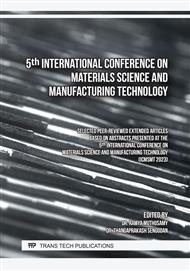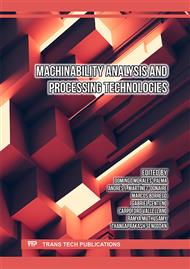[1]
EN 1996-1-1, Eurocode 6 - Design of masonry structures - Part 1-1. European Committee for Standardization, 2005.
Google Scholar
[2]
NEC-SE-MP, Norma Ecuatoriana de la Construcción. Mampostería Estructural. Ecuador: Ministerio de Desarrollo Urbano y Vivienda, 2015.
Google Scholar
[3]
ACI 530-13, Building Code Requirements and Specification for Masonry Structures. USA: American Concrete Institute, 2013.
Google Scholar
[4]
SP 15.13330.2020, Masonry and reinforced masonry structures. Moscow, Russian Federation: Minstroy Rossii, 2020.
Google Scholar
[5]
P.B. Lourenço, Computational strategies for Mansory structures, Doctoral Thesis. Delft University, 1996.
Google Scholar
[6]
J. López, S. Oller, and E. Oñate, Cálculo del Comportamiento de la Mampostería Mediante Elementos Finitos. Barcelona, 1998.
Google Scholar
[7]
V. V. Pangaev, Model studies of the stress-strain state of the masonry in compression (in Russian), News High. Educ. Institutions. Constr., no. 2, p.24–29, (2003).
Google Scholar
[8]
Kashevarova G.G. and N. A. Trufanov, Numerical analysis of the effective elastic properties of masonry material (in Russian), Mech. Compos. Mater. Struct., vol. 11, no. 1, p.49–60, (2005).
Google Scholar
[9]
J. V. Lemos, Discrete element modeling of masonry structures, Int. J. Archit. Herit., vol. 1, no. 2, p.190–213, (2007).
DOI: 10.1080/15583050601176868
Google Scholar
[10]
T. Celano, L. U. Argiento, F. Ceroni, and C. Casapulla, In-plane behaviour of masonry walls: Numerical analysis and design formulations, Materials (Basel)., vol. 14, no. 19, (2021).
DOI: 10.3390/ma14195780
Google Scholar
[11]
R. Sousa, H. Sousa, and J. Guedes, Diagonal compressive strength of masonry samples - Experimental and numerical approach, Mater. Struct. Constr., vol. 46, no. 5, p.765–786, (2013).
DOI: 10.1617/s11527-012-9933-z
Google Scholar
[12]
O. V. Kabantsev, Modeling Nonlinear Deformation and Destruction Masonry under Biaxial Stresses Part 1 – Masonry as Simulation Object, Appl. Mech. Mater., vol. 725–726, p.681–696, (2015).
DOI: 10.4028/www.scientific.net/amm.725-726.681
Google Scholar
[13]
O. V. Kabantsev, Scientific basis of the structural theory of masonry for the assessment of limit states of masonry structures in earthquake resistant buildings (in Russian), Post-Doctoral Thesis. Moscow State University of Civil Engineering, Moscow, 2016.
Google Scholar
[14]
A. W. Hendry, Shear Strength Criteria and Related Tests for Brick Masonry, Adv. Struct. Eng., vol. 1, no. 2, p.135–141, (1997).
DOI: 10.1177/136943329700100205
Google Scholar
[15]
J. Nichols and Y. Totoev, Experimental determination of the dynamic Modulus of Elasticity of masonry units, in 15th Australian Conference on the Mechanics of Structures and Materials, 1997, no. January, p.1–7.
Google Scholar
[16]
A. Gabor, E. Ferrier, E. Jacquelin, and P. Hamelin, Analysis and modelling of the in-plane shear behaviour of hollow brick masonry panels, Constr. Build. Mater., vol. 20, no. 5, p.308–321, (2006).
DOI: 10.1016/j.conbuildmat.2005.01.032
Google Scholar
[17]
G. Andreotti, F. Graziotti, and G. Magenes, Detailed micro-modelling of the direct shear tests of brick masonry specimens: The role of dilatancy, Eng. Struct., vol. 168, no. July 2017, p.929–949, (2018).
DOI: 10.1016/j.engstruct.2018.05.019
Google Scholar
[18]
R. Capozucca, E. Magagnini, and G. Pace, FE Modelling of Experimental Brickwork Masonry Building Under Eccentric Shear Force, Open Civ. Eng. J., vol. 11, no. 1, p.1036–1058, (2017).
DOI: 10.2174/1874149501711011036
Google Scholar
[19]
C. Chácara, F. Cannizzaro, B. Pantò, I. Caliò, and P. B. Lourenço, Seismic vulnerability of URM structures based on a Discrete Macro-Element Modeling (DMEM) approach, Eng. Struct., vol. 201, no. 109715, p.16, (2019).
DOI: 10.1016/j.engstruct.2019.109715
Google Scholar
[20]
P. Morandi, C. Butenweg, and G. Magenes, Latest Findings on the Behaviour Factor q for the Seismic Design of URM Buildings, Bull. Earthq. Eng., p.42, (2021).
DOI: 10.21203/rs.3.rs-633901/v1
Google Scholar
[21]
A.M. D'Altri, F. Cannizzaro, M. Petracca, and D.A. Talledo, Nonlinear modelling of the seismic response of masonry structures : Calibration strategies, Bull. Earthq. Eng., vol. 19, no. 7, p.11–55, (2021).
DOI: 10.1007/s10518-021-01104-1
Google Scholar
[22]
K.F. Abdulla, L. S. Cunningham, and M. Gillie, Simulating masonry wall behaviour using a simplified micro-model approach, Eng. Struct., vol. 151, p.349–365, (2017).
DOI: 10.1016/j.engstruct.2017.08.021
Google Scholar
[23]
W. Jäger, T. Bakeer, and P. Schöps, Simulation of Masonry in ANSYS and LS-DYNA. The Features and Challenges, in ANSYS Conference & 27th CADFEM Users' Meeting, 2009, p.1–15.
Google Scholar
[24]
A. W. Page, The biaxial compressive strength of brick masonry, Proc. Inst. Civ. Eng. (London). Part 1 - Des. Constr., vol. 71, no. pt 2, p.893–906, (1981).
DOI: 10.1680/iicep.1981.1825
Google Scholar
[25]
S. Fattal and F. Jokel, Failure hypothesis for masonry shear walls, Proc. ASCE, vol. 102, no. ST3, p.515–532, (1976).
Google Scholar
[26]
O.V. Kabantsev, Particular criteria for the strength of masonry for the analysis of elastic-plastic deformation (in Russian), Earthquake-resistant Constr. Saf. Struct., p.36–41, (2013).
Google Scholar
[27]
L.I. Onischik, Masonry structures (in Russian). Moscow - Leningrad: Stroyizdat, 1939.
Google Scholar
[28]
N. Laskov, Strength and deformability of monolithic large-panel and masonry walls (in Russian), Penza State Academy of Architecture and Civil Engineering, 2002.
Google Scholar
[29]
A.V. Tumanov, Strength of reinforced masonry walls under the combined action of vertical and horizontal forces (in Russian), Penza State Academy of Architecture and Civil Engineering, 2000.
Google Scholar
[30]
S. V. Polyakov and S. M. Safargaliev, Seismic resistance of buildings with load-bearing brick walls (in Russian). Almaty, 1988.
Google Scholar
[31]
D. Cajamarca-Zuniga, O. V. Kabantsev, and C. Marin, Macroseismic intensity-based catalogue of earthquakes in Ecuador, Struct. Mech. Eng. Constr. Build., vol. 18, no. 2, p.161–171, (2022), doi: http://doi.org/10.22363/1815-5235-2022- 18-2-161-171.
DOI: 10.22363/1815-5235-2022-18-2-161-171
Google Scholar
[32]
S. V. Polyakov, Bonding in Brickwork. Moscow: Gos Stroyizdat, 1959.
Google Scholar
[33]
EN 1052-3-2002, Methods of test for masonry - Part 3 - Shear Strength. European Union: European Committee for Standarization, 2007.
Google Scholar
[34]
O. Kabantsev and D. Cajamarca-zuniga, Proposal for improving the solid clay brick contact surface to increase the initial shear strength of masonry, Mater. Today Proc., vol. 83, no. 2, p.8, (2023).
DOI: 10.1016/j.matpr.2023.05.640
Google Scholar
[35]
M. R. Maheri, F. Motielahi, and M. A. Najafgholipour, The effects of pre and post construction moisture condition on the in-plane and out-of-plane strengths of brick walls, Mater. Struct. Constr., vol. 44, no. 2, p.541–559, (2011).
DOI: 10.1617/s11527-010-9648-y
Google Scholar
[36]
ASTM C321-00, Standard Test Method for Bond Strength of Mortar to Masonry Units. USA: ASTM International, 2012.
Google Scholar
[37]
GOST-24992-2014, Masonry Structures. Method of Estimating Bonding Strength in Masonry. Russia: Interstate Council for Standarization Metrology and Certification (ISC), 2015.
Google Scholar
[38]
A. V. Antsibor and M. I. Brusser, Determining and assessing the strength of mortar and fine-grained concrete in structures (in Russian), Concr. Reinf. Concr., vol. 576, no. 3, p.2–4, (2012).
Google Scholar
[39]
ASTM C270-10, Standard Specification for Mortar for Unit Masonry. USA: ASTM International, 2010.
Google Scholar



